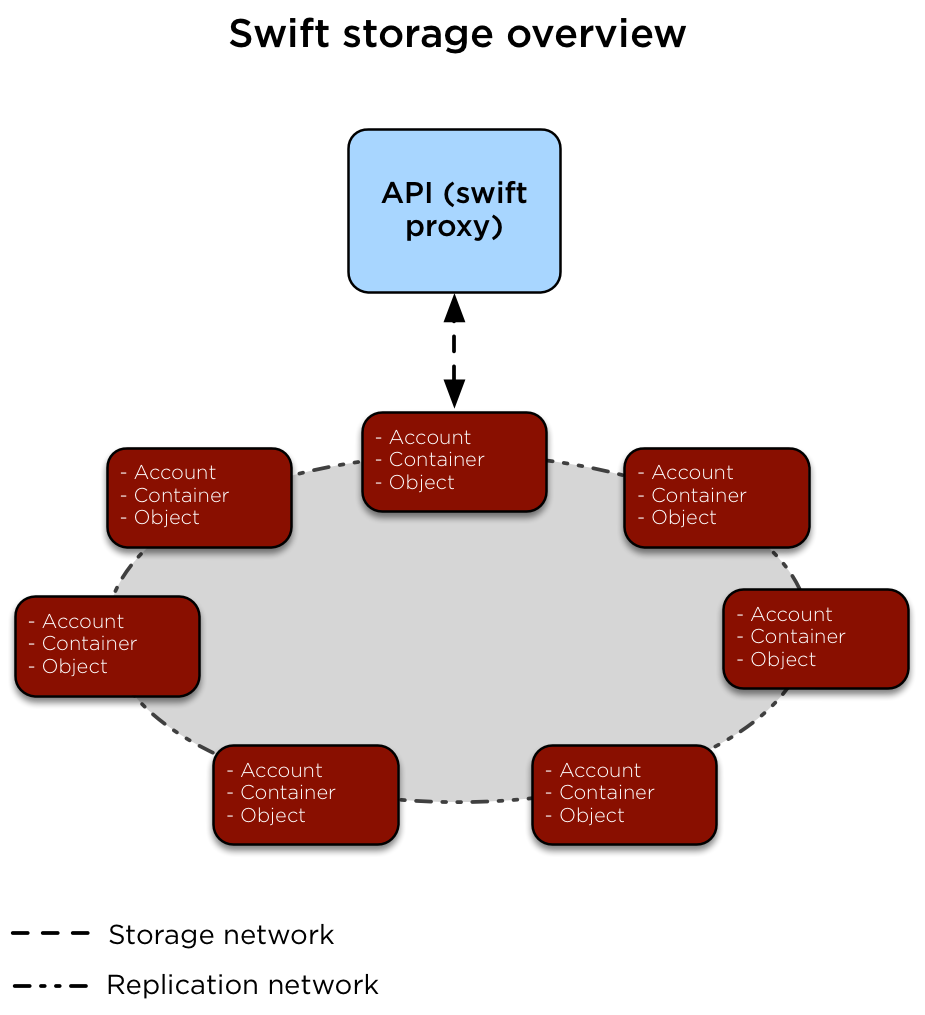Storage architecture¶
OpenStack has multiple storage realms to consider:
- Block Storage (cinder)
- Object Storage (swift)
- Image storage (glance)
- Ephemeral storage (nova)
Block Storage (cinder)¶
The Block Storage (cinder) service manages volumes on storage devices in an
environment. In a production environment, the device presents storage via a
storage protocol (for example, NFS, iSCSI, or Ceph RBD) to a storage network
(br-storage) and a storage management API to the
management network (br-mgmt). Instances are connected to the volumes via
the storage network by the hypervisor on the Compute host.
The following diagram illustrates how Block Storage is connected to instances.

The diagram shows the following steps.
A volume is created by the assigned cinder-volume service
using the appropriate cinder driver. The volume is created by
using an API that is presented to the management network. |
|
After the volume is created, the nova-compute service connects
the Compute host hypervisor to the volume via the storage network. |
|
| After the hypervisor is connected to the volume, it presents the volume as a local hardware device to the instance. |
Important
The LVMVolumeDriver is designed as a reference driver implementation,
which we do not recommend for production usage. The LVM storage back-end
is a single-server solution that provides no high-availability options.
If the server becomes unavailable, then all volumes managed by the
cinder-volume service running on that server become unavailable.
Upgrading the operating system packages (for example, kernel or iSCSI)
on the server causes storage connectivity outages because the iSCSI service
(or the host) restarts.
Because of a limitation with container iSCSI connectivity, you must deploy
the cinder-volume service directly on a physical host (not into a
container) when using storage back ends that connect via iSCSI. This includes
the LVMVolumeDriver and many of the drivers for commercial storage devices.
Note
The cinder-volume service does not run in a highly available
configuration. When the cinder-volume service is configured to manage
volumes on the same back end from multiple hosts or containers, one service
is scheduled to manage the life cycle of the volume until an alternative
service is assigned to do so. This assignment can be made through the
cinder-manage CLI tool. This configuration might change if
cinder volume active-active support spec is implemented.
Object Storage (swift)¶
The Object Storage (swift) service implements a highly available, distributed, eventually consistent object/blob store that is accessible via HTTP/HTTPS.
The following diagram illustrates how data is accessed and replicated.

The swift-proxy service is accessed by clients via the load balancer
on the management network (br-mgmt). The swift-proxy service
communicates with the Account, Container, and Object services on the
Object Storage hosts via the storage network(br-storage). Replication
between the Object Storage hosts is done via the replication network
(br-repl).
Image storage (glance)¶
The Image service (glance) can be configured to store images on a variety of storage back ends supported by the glance_store drivers.
Important
When the File System store is used, the Image service has no mechanism of
its own to replicate the image between Image service hosts. We recommend
using a shared storage back end (via a file system mount) to ensure that
all glance-api services have access to all images. Doing so prevents
losing access to images when an infrastructure (control plane) host is lost.
The following diagram illustrates the interactions between the Image service,
the storage device, and the nova-compute service when an instance is
created.

The diagram shows the following steps.
| 1 | When a client requests an image, the glance-api service
accesses the appropriate store on the storage device over the
storage network (br-storage) and pulls it into its cache. When
the same image is requested again, it is given to the client
directly from the cache. |
| 2 | When an instance is scheduled for creation on a Compute host, the
nova-compute service requests the image from the glance-api
service over the management network (br-mgmt). |
| 3 | After the image is retrieved, the nova-compute service stores
the image in its own image cache. When another instance is created
with the same image, the image is retrieved from the local base
image cache. |
Ephemeral storage (nova)¶
When the flavors in the Compute service are configured to provide instances
with root or ephemeral disks, the nova-compute service manages these
allocations using its ephemeral disk storage location.
In many environments, the ephemeral disks are stored on the Compute host’s local disks, but for production environments we recommend that the Compute hosts be configured to use a shared storage subsystem instead. A shared storage subsystem allows quick, live instance migration between Compute hosts, which is useful when the administrator needs to perform maintenance on the Compute host and wants to evacuate it. Using a shared storage subsystem also allows the recovery of instances when a Compute host goes offline. The administrator is able to evacuate the instance to another Compute host and boot it up again. The following diagram illustrates the interactions between the storage device, the Compute host, the hypervisor, and the instance.

The diagram shows the following steps.
| 1 | The Compute host is configured with access to the storage device.
The Compute host accesses the storage space via the storage network
(br-storage) by using a storage protocol (for example, NFS,
iSCSI, or Ceph RBD). |
| 2 | The nova-compute service configures the hypervisor to present
the allocated instance disk as a device to the instance. |
| 3 | The hypervisor presents the disk as a device to the instance. |

Except where otherwise noted, this document is licensed under Creative Commons Attribution 3.0 License. See all OpenStack Legal Documents.